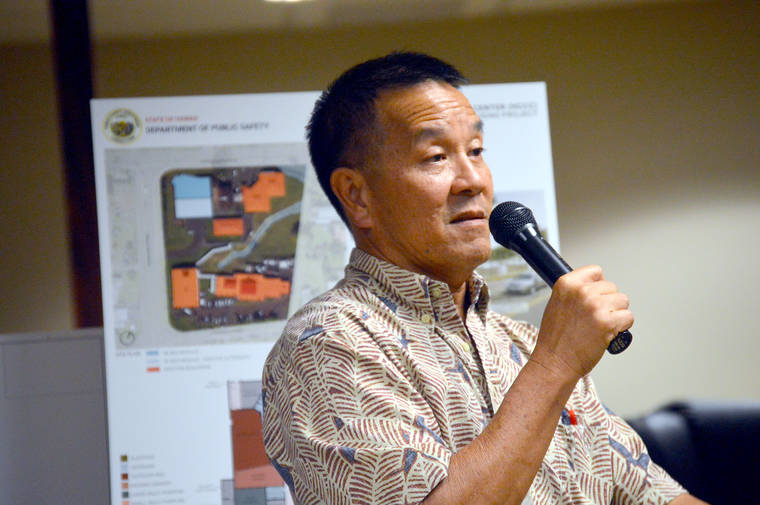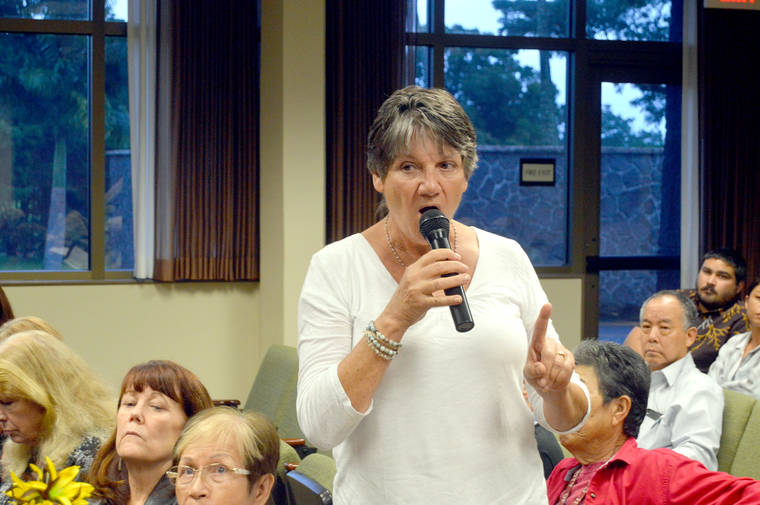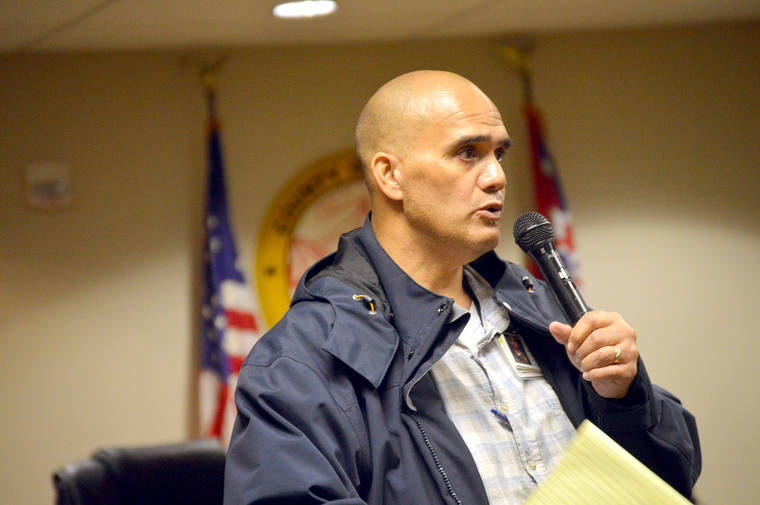Community speaks out against jail expansion



Officials from the state Departments of Public Safety and Accounting and General Services came to Hilo Thursday night to brief the public about the planned new housing module at Hawaii Community Correctional Centers Punahele Street site.
Officials from the state Departments of Public Safety and Accounting and General Services came to Hilo Thursday night to brief the public about the planned new housing module at Hawaii Community Correctional Center’s Punahele Street site.
What they got instead is an earful, mostly from angry neighbors who think the expansion — originally planned to house 144 inmates but scaled back to 48 because of funding — will do little, if anything, to ease chronic overcrowding at HCCC, and will make their neighborhood more dangerous.
ADVERTISING
No audience member spoke in favor of the facility the Legislature appropriated $12.8 million to build.
Richard Louis, a Department of Accounting and General Services official assigned to the Neighbor Island Jails Project, told the 30-some members of the public the purpose of the housing unit, which looks more like a college dormitory than a jail, is “to help on the overcrowding at this particular jail.”
Designed to hold 226 inmates, the Big Island’s only jail, which has two Hilo campuses, had a Nov. 30 population of 428 — 342 men and 86 women. It is the most crowded correctional center in the state.
Louis also said officials are adding feedback letters and responses to the draft environmental assessment, which was completed May 10, to the final EA submission.
“Time-frame wise, we’re hoping to do this by, hopefully, February,” Louis said. “And February, March, we’re looking to bid out this particular project that’s for this housing unit. … The estimated bid opening would probably be late March or April of this year. … Construction is 420 days from when notice to proceed is given … to whoever is successfully selected as contractor.”
Kiki Rycraft, a neighbor of the jail and president of the Halai Kumiai community group, called the project “more or less, a lose-lose situation” and said it wouldn’t “put a dent in the overcrowding.”
“Right now, there are 186 inmates over capacity at (the Punahele) site,” Rycraft said, and added jail staffers are “tired, they’re burned out, and they’re angry.”
Rycraft said the overcrowding “is not just a burden on the jail, it’s a burden on the neighboring community.”
“I urge all of you to take a look at that floor plan,” she said. “… Forty-eight beds for $13 million? I think that we can do a whole lot better for our inmates and our prison staff than what we’re doing with that building and on that budget.”
Tessie Fernandez of DPS’s Administrative Services Office, acknowledged the project won’t solve the overcrowding, but called it “our only chance … to build something so we can at least have 48 beds.”
“It took us this long to get funding from the Legislature,” Fernandez said. “The Legislature in 2016 appropriated $15 million to HCCC, $15 million to (Kauai Community Correctional Center), and we requested $15 million for Maui, but they only gave us $7.5 million. So we can only build so much. And when the design was finally completed, this is what we could build based on the standards of the … American Correctional Association.”
Acting HCCC Warden Cramer Mahoe said the jail is understaffed and has morale issues among staff. He added inmates “have an end date” when they will be released into the community, and an upgrade to the facility will help both staff morale and inmate rehabilitation.
“Studies across America (show) when they treat them as normal human beings and give them conditions that look relatively normal, as being at home, they’re not as aggressive to the staff, they’re better to rehabilitate. Their transition out into the community is better,” he said.
Halai Kumiai member Annette Fujii questioned the “vision” for the facility and whether it would be effective in solving overcrowding.
“This population is going to grow,” Fujii said. “And in the meantime, we’re going to accept scraps because your workers are at wit’s end? Well, the community is at wit’s end.”
One woman complained of recently released inmates causing trouble in the neighborhood, including one who entered her property and used her garden hose to bathe himself.
“I found drug paraphernalia in my yard, and not just crutches. Like bottles of some sort of pills and pipes. … I have three daughters …,” she said. “I already won’t let my kids play in the yard by themselves. They have to be supervised.”
Several complained of a lack of public meetings during the draft EA process.
“We receive these notices that, by law, you’re required to have community input,” said Lynne Aquino. “It sounds like this community input is absolutely worthless, because you’re already ready to go out to bid. Is that true? It’s a done deal no matter what we say?”
“It’s done. You’re going to build it. It’s already predetermined. So did you have the process, and did I have the opportunity to address (issues) through a public hearing?” added Patrick Kahawaiolaa, president of the Keaukaha Community Association.
“My understanding is we have met the requirements (of the draft EA) — one of which, unfortunately, much to your chagrin, is that there is not a requirement to have a public meeting,” Louis replied. “There’s public information that’s sent out that’s open to the public to respond to that.”
County Council Chairman Aaron Chung, a neighbor of the jail, said Councilwoman Sue Lee Loy, a land-use planner, told him there’s “no requirement of a public meeting nor any formal notice” in the draft EA process.
“The only notice that is put out on an EA is with the Office of Environmental Quality Control, and it’s in a publication,” Chung said. “… And unless you know about something like this — and who the hell reads these things, right? — no one will ever know. So you would think that maybe best practices would sort of tell people who are in positions of doing these EAs to sort of solicit community input.”
Cheryl Reis, a retired police major who lives near the jail, told Mahoe a big problem is a lack of communication between jail officials and neighbors.
“In order for all of this to succeed, we have to have dialogue, we have to have discussions. We have to know what your problems are. You have to know what our problems are,” Reis said.
“And together, we need to work the problems out. … This meeting here is really not going to solve anything, because there are so many issues that have been allowed to fester over the years. And there is nobody here from DPS who can give any definitive decision on what can be done or accept our suggestions to try to work these problems out.”
Email John Burnett at jburnett@hawaiitribune-herald.com.


